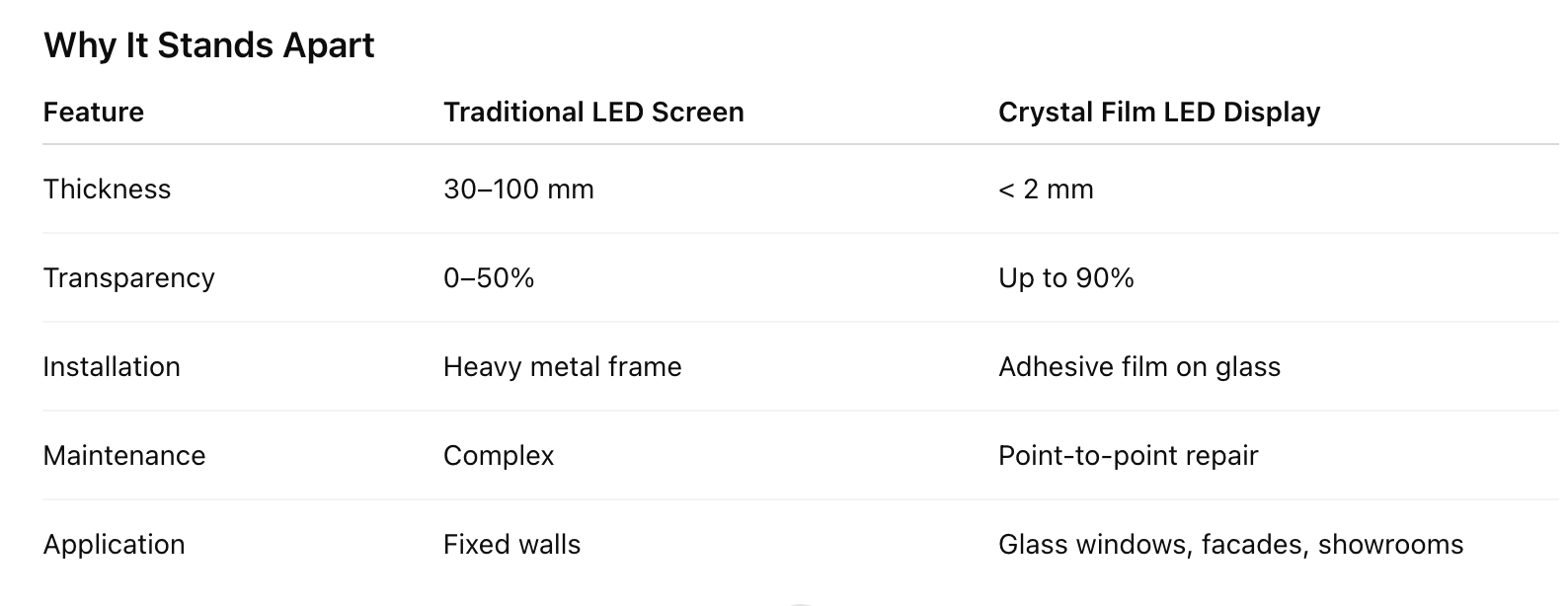2025-10-30
In the world of digital displays, innovation never stands still. The arrival of the Transparent Film LED Display marks a new milestone — a stunning combination of transparency, flexibility, and ultra-thin design that redefines how we think about visual communication. If traditional LED screens were windows into digital content, the new Transparent Film LED is the window itself — bright, clear, and almost invisible when turned off.
1. Ultra-Thin and Feather-Light Design Display
The Transparent Film LED screen is a marvel of minimalist engineering. With a thickness of less than 2 millimeters and an ultra-lightweight structure, it eliminates the bulk of conventional LED cabinets. This means no heavy metal frames, no cumbersome installation structures, and no visible borders — only pure, seamless display.
Imagine turning a piece of glass into a vibrant storytelling canvas — that’s the essence of the Crystal Film LED.
The screen’s film-based substrate allows it to adhere directly to glass or other transparent surfaces, making it ideal for retail storefronts, exhibition halls, corporate lobbies, and smart architecture. Wherever transparency meets creativity, the Transparent Film LED fits perfectly.
2. Transparency Meets Brilliance
One of the most striking advantages of this technology is its high transparency rate — up to 90%. This ensures that when the display is off, it blends naturally with its surroundings, maintaining the openness and brightness of the space.
When it lights up, the contrast and color reproduction are breathtaking. The high-brightness LEDs ensure vivid visuals even in direct sunlight, while the film’s optical clarity allows viewers to see both the displayed content and the background environment — a perfect balance between digital and real-world beauty.
Compared to traditional transparent LED panels, the Transparent Film LED features higher pixel density and more uniform color distribution, achieving both clarity and consistency without the “grid” effect common in earlier transparent screens.
3. Flexible Installation and Maintenance-Free Design
Forget about complex structural setups. The adhesive film layer can be directly applied to existing glass surfaces, instantly transforming them into dynamic digital displays. This plug-and-play approach drastically reduces installation time and costs.
The absence of metal components also means better heat dissipation and zero noise, creating a cleaner and quieter environment.
Maintenance is nearly effortless — with modular pixel repair technology, users can easily replace individual light points without dismantling the entire display. This ensures long-term reliability and lower operational costs for businesses.
4. Energy Efficiency and Environmental Responsibility
The Transparent Film LED Display isn’t just smarter — it’s greener. Thanks to its low-power components and superior light transmittance, energy consumption is 30–40% lower than traditional LED displays.
Its thin-film architecture also uses fewer raw materials, reducing both weight and waste. For companies committed to sustainable innovation, it represents a new standard in eco-friendly display technology.
5. A New Canvas for Imagination
From flagship stores showcasing brand stories to futuristic glass facades that come alive at night, the Transparent Film LED Display empowers designers and marketers to merge digital creativity with architectural aesthetics.
It enables a seamless dialogue between technology and space — transforming ordinary glass into immersive visual experiences that engage and inspire.
In airports, museums, hotels, and smart cities, this new generation of transparent display technology is already reshaping how information and emotion are shared.

In Summary
The Transparent Film LED Display represents not just a technological evolution, but a redefinition of space and light. It turns transparency into a storytelling medium, merges form with function, and brings digital visuals into the real world with elegance and efficiency.
In a future where architecture and media converge, the Transparent Film LED isn’t just another screen — it’s the future of visual communication.





